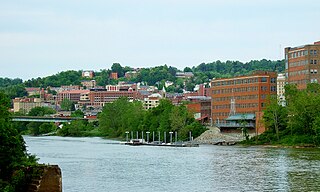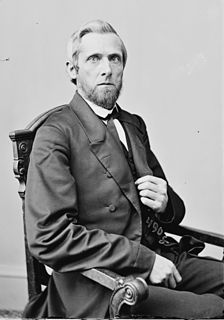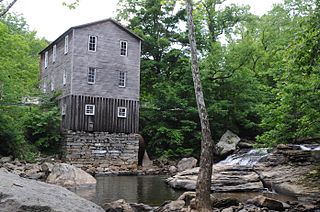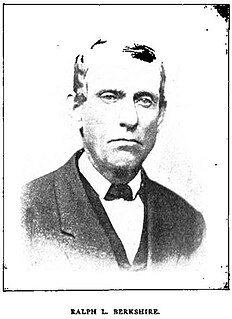Interstate 68 (I-68) is a 112.9-mile (181.7 km) Interstate Highway in the U.S. states of West Virginia and Maryland, connecting I-79 in Morgantown, West Virginia, to I-70 in Hancock, Maryland. I-68 is also Corridor E of the Appalachian Development Highway System. From 1965 until the freeway's construction was completed in 1991, it was designated as U.S. Route 48 (US 48). In Maryland, the highway is known as the National Freeway, an homage to the historic National Road, which I-68 parallels between Keysers Ridge and Hancock. The freeway mainly spans rural areas and crosses numerous mountain ridges along its route. A road cut at Sideling Hill exposed geological features of the mountain and has become a tourist attraction.

Monongalia County, known locally as Mon County, is a county in the U.S. state of West Virginia. As of the 2010 census, the population was 96,189, making it West Virginia's fourth-most populous county. Its county seat is at Morgantown. The county was founded in 1776. Monongalia County is included in the Morgantown, WV Metropolitan Statistical Area, and is the largest county in North-Central West Virginia. It is part of the Pittsburgh media market.

Scouting in West Virginia has a long history, from the 1910s to the present day, serving thousands of youth in programs that suit the environment in which they live.

Morgantown is the county seat of Monongalia County, West Virginia, United States, situated along the Monongahela River. West Virginia University is located in the city. The population was 29,660 at the 2010 Census Bureau, making Morgantown the largest city in North-Central West Virginia. The Morgantown metropolitan area has a population of 138,176.

Star City is a town in Monongalia County, West Virginia, United States. The population was 1,825 at the 2010 census. It is included in the Morgantown, West Virginia Metropolitan Statistical Area.

Waitman Thomas Willey was an American lawyer and politician from Morgantown, West Virginia. One of the founders of the state of West Virginia during the American Civil War, he served in the United States Senate representing first the Restored Government of Virginia and became one of the new state of West Virginia's first two Senators.

The Harner Homestead, is a historic home outside Morgantown, Monongalia County, West Virginia.

The Monongalia Arts Center, or MAC, is located in Morgantown, West Virginia near the campus of West Virginia University. The MAC opened to the public in 1978 as a non-profit arts and culture center, which it remains today. The MAC's mission is "to provide a home for the arts where the work of visual and performing artists is showcased and interest in the arts is nurtured through ongoing educational programs." The building hosts two galleries, a theatre for the performing arts, and is undergoing production on other projects, including an Internet radio station and the establishment of the Tanner Theatre as a regular venue for touring bands. The building is also recognized on the National Register of Historic Places.

Price's Mill, also known as Calliham's (Callaham's) Mill, Stone's Mill, and Park's Mill, is a water-powered gristmill about 2 mi (3 km) east of the town of Parksville on South Carolina Highway 33-138 at Stevens Creek in McCormick County. Its name in the USGS Geographic Names Information System is Prices Mill. It was built in the 1890s and was named to the National Register of Historic Places on November 22, 1972. At this time, it was one of the few remaining water-powered gristmills in South Carolina.

Walters House, also as known as the Walters Residence, is a historic home located in Morgantown, Monongalia County, West Virginia. It was built about 1900-1901, and is a brick Queen Anne style brick dwelling. It features a three-story tower in the southeast corner topped with a wrought-iron balustrade. The architect is unknown. It was a single family home until 1931, after which it was a boarding house, fraternity house, home of the University Christian Council, and law offices. It is currently the location of the Morgantown Chabad Jewish Center. It was listed on the National Register of Historic Places in 1983. It is located in the Downtown Morgantown Historic District, listed in 1996.

Fidler's Mill is a historic grist mill located at Arlington, Upshur County, West Virginia. It was built in 1847-1849 and enlarged in 1916. It is a two to four story frame building built of yellow poplar on a stone foundation. The mill provided ground wheat and buckwheat for flour, and ground cornmeal, and also housed wool carding machines, which were used seasonally.

Brown Building, also known as the Ream Building, is a historic commercial building located at Morgantown, Monongalia County, West Virginia. It was designed in 1898 by noted Morgantown architect Elmer F. Jacobs. It is a four-story eclectic style brick building. It has a flat roof and projecting cornice. It has a ball finial and parapet centered on the front facade. It features polychromatic brick detailing, accentuated bays and a triad of double-sash windows

Rogers House is a historic home located at Morgantown, Monongalia County, West Virginia. It was originally built about 1857 and is one of the last remaining residences from this time period in downtown Morgantown. The building is a two-story, five bay brick and wood frame dwelling in the Classical Revival style. The original section of the house is in brick, whereas the addition, designed by noted Morgantown architect Elmer F. Jacobs and built in 1905-1906 is wood frame. Jacobs is also responsible for the interior design. It sits on a rough-faced coursed ashlar stone foundation. It features a front porch with four sets of triple wooden, Tuscan order columns. It was the home of the Rogers family, pioneer settlers of Morgantown. It has been the home of West Virginia University's Campus Ministry Center since 1984. It was listed on the National Register of Historic Places in 1984. It is located in the Downtown Morgantown Historic District, listed in 1996.

Old Stone House is a historic home located at Morgantown, Monongalia County, West Virginia. The original section was built about 1796, and is a two-story stone structure measuring 26 feet, 8 inches, by 20 feet, 8 inches. A one-story, timber frame addition built in the early 1900s and measures 16 feet, 7 inches, by 16 feet, 4 inches. The Old Stone House was the home of John W. Thompson, a potter in early Morgan's Town. He was able to create red ware and stoneware pots from the clay found in the basement of the house. It is one of the oldest surviving examples of rustic pioneer architecture in Monongalia County. In 1935, it became headquarters of the Morgantown Service League, who operates a gift shop in the house.

Monongalia County Courthouse is a historic courthouse building located in Morgantown, Monongalia County, West Virginia. The courthouse was erected in 1784 with the current structure built in 1891. This Romanesque style building consists of a two-story building with a basement, five-story clock tower and a three-story South tower. The building measures at 99’ by 83’ by 99’ by 76’ with the first story at fifteen feet high and the second story at twenty-two feet high. The distinctive central clock tower has a pyramidal roof, four doomed buttresses, stone molds over the four clocks and tower windows, arcade belfry, and quatrefoil design with the building date. The original northern facade was covered by an addition built in 1925 with another addition built in 1975. Connected to the courthouse is a two-story Italianate style jailhouse built in 1881.

Kincaid and Arnett Feed and Flour Building is a historic warehouse building located at Morgantown, Monongalia County, West Virginia. It was built between 1904 and 1906, and is a three-story, vernacular brick warehouse located along the banks of the Monongahela River. It is trapezoid shaped and has a prominent concrete-block loading dock with overhead canopy. Kincaid and Arnett functioned as a prosperous wholesale and retail grain dealership and brokerage until they sold the property to Morgantown Feed and Flour Corporation in February 1921.

Seneca Glass Company Building, now called Seneca Center, is a historic glass factory located at Morgantown, Monongalia County, West Virginia. It was built by the Seneca Glass Company in 1896–1897, and is an industrial complex of work areas, all connected by doors, passageways, or bridges. A fire in 1902, destroyed much of the interior of the original brick part of the complex. After the fire, Elmer F. Jacobs designed the new two-story replacement, a new Needle Etching Room in a separate building connected by a bridge, and the reconstruction of the Grinding, Glazing, and Cutting areas. A large addition was built in 1947. The building features a conical brick stack that projects 36 feet above the roofline of the Furnace / Blowing Room. The complex was the home of one of the finest hand-blown, hand-cut and etched, lead glass factories in the world. After the factory closed in 1983, it was adapted for commercial use.

The Downtown Morgantown Historic District is a federally designated historic district in Morgantown, Monongalia County, West Virginia. The district, encompassing approximately 75 acres, has 122 contributing buildings and 2 contributing sites including commercial and public buildings, residences, and churches. The district has been listed on the National Register of Historic Places since May 2, 1996. Ten of the contributing buildings are listed separately on the National Register of Historic Places. Significant structures located within the historic district are the Monongalia County Courthouse, the Metropolitan Theater, and the Old Morgantown Post Office.
American Sheet and Tin Plate Company was an American industrial company specialized in tinplate products. The company produced sheets of steel, coated with a thin layer of tin.

Ralph Lazier Berkshire was a lawyer, judge, and Republican politician who helped found the state of West Virginia and became the first Chief Justice of the Supreme Court of Appeals of West Virginia. Although defeated for re-election, Berkshire again served from September 10, 1868 until December 31, 1872, and later represented Monongalia County in the West Virginia Senate (1874-1878) as well as continued practicing law.





















